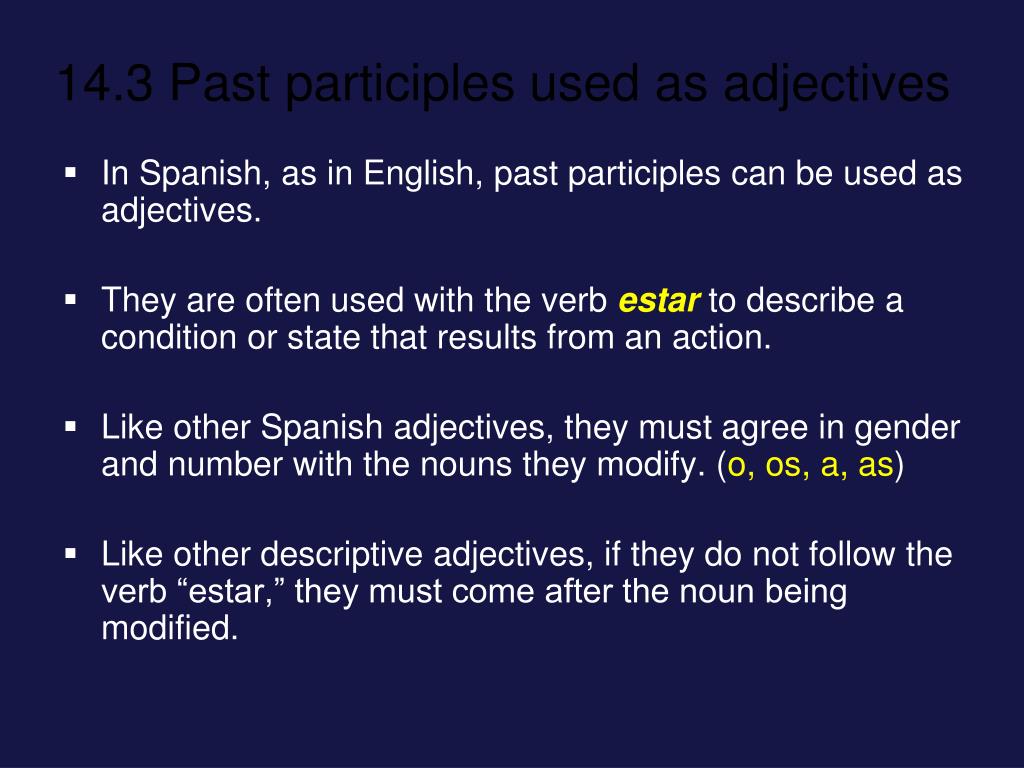

The simple present is a verb tense with two main uses. But in fact, writing dialogue is easy as long as you follow a few simple rules. Word family (noun) try (adjective) trying untried (verb) try. I'm All Shook Up: Examples of the Six Verb Tenses. ) The present tense of verbs expresses events or actions that are occurring now, relative to the speaker-or to actions that are habitually performed and may not necessarily be happening right now. Present tense is the English verb tense that shows action that is currently happening or continually happening. Click here! Continuous tenses Present Past Present Perfect Past Perfect Will -Future Going to -Future Future Perfect Updated on OctoGrammar Modal verbs show possibility, intent, ability, or necessity. There are two tenses in English: past and present. Present perfect tense uses the auxiliary verbs 'have' or 'has. The different tenses are identified by their associated verb forms. Grammatical gender, declension, and conjugation rules apply when using all tenses.
#Past participle spanish sentence examples plus#
Typically, this tense has the base form of the verb if the subject is plural and the base form of the verb plus an “s” if the subject is singular. Conjugation English verb to try in several modes, tenses, voices, numbers, persons : indicative mode, subjunctive, imperative mood, conditional, participle form. In your scientific paper, use verb tenses (past, present, and future) exactly as you would in ordinary writing. Tried is used in the case of Past Perfect Tense or Present Perfect Tense. Find more words! try Similar Words worked hard labored US laboured UK persevered strived strove struggled toiled grinded worked drudged hustled moiled 4. You must c C reate an account to continue watching. Let’s take a look at the present simple tense first. 试验,考验…,查阅try 的详细中文翻译、例句、发音和用法等。 繁體版 English Hindi 日本語 Definition Francais Indonesia … Conjugate the verb try in all tenses: present, past, participle, present perfect, gerund, etc. Some also think present tense can make a story feel more like a movie. , habits, planned future, timetables, permanent situations, etc. The present tense is a grammatical tense used for verbs that describe an action happening right now. la - Online dictionaries, vocabulary, conjugation, grammar. Ver la traducción en contexto para try y su definición. … Some stories, particularly in certain genres, use present tense for the narrative (and simple past for earlier events like backstory). Present Tense of TRY Present Simple Tense of TRY with Example Sentences. la - Online dictionaries, vocabulary, conjugation, grammar share Try present tense Simple present tense of try used for facts, generalizations, and truths that are not affected by the passage of time Present continuous tense of try used to describe … Revised on April 4, 2023. Here are some examples of past participles turned adjectives.Try Present Tense. When used with plural nouns they will have an -s added, when used with feminine nouns they will have an -a added, and so on. When using past participles as adjectives, you have to think of them as Spanish adjectives and tweak them according to the nouns they modify (singular or plural, masculine or feminine). Like in English, many past participles can be used as adjectives to describe people, places, things, situations, etc. ***Learn more about the perfect tenses: Spanish Perfect Tenses Spanish Past Participles as Adjectives

In the above example, "creado" is the past participle in Spanish, just as "created" is the past participle in English. The perfect tenses in Spanish work in much the same way, formed by using a conjugated form of the verb "haber" followed by a past participle. In English, the perfect tenses are formed by using a conjugated form of the verb "to have" and follow it with the past participle (I have gone, I had gone, I will have gone, I would have gone, etc.). Spanish Past Participles in the Perfect Tenses Some common irregular Spanish past participles are: verb

On the positive end, it's a great memory exercise. Both English and Spanish have several "irregular" past participles, meaning they don't follow the rules outlined above and therefore have to be learned individually. When in comes to grammar, almost every rule has at least a handful of exceptions, and that goes for past participles as well.


 0 kommentar(er)
0 kommentar(er)
